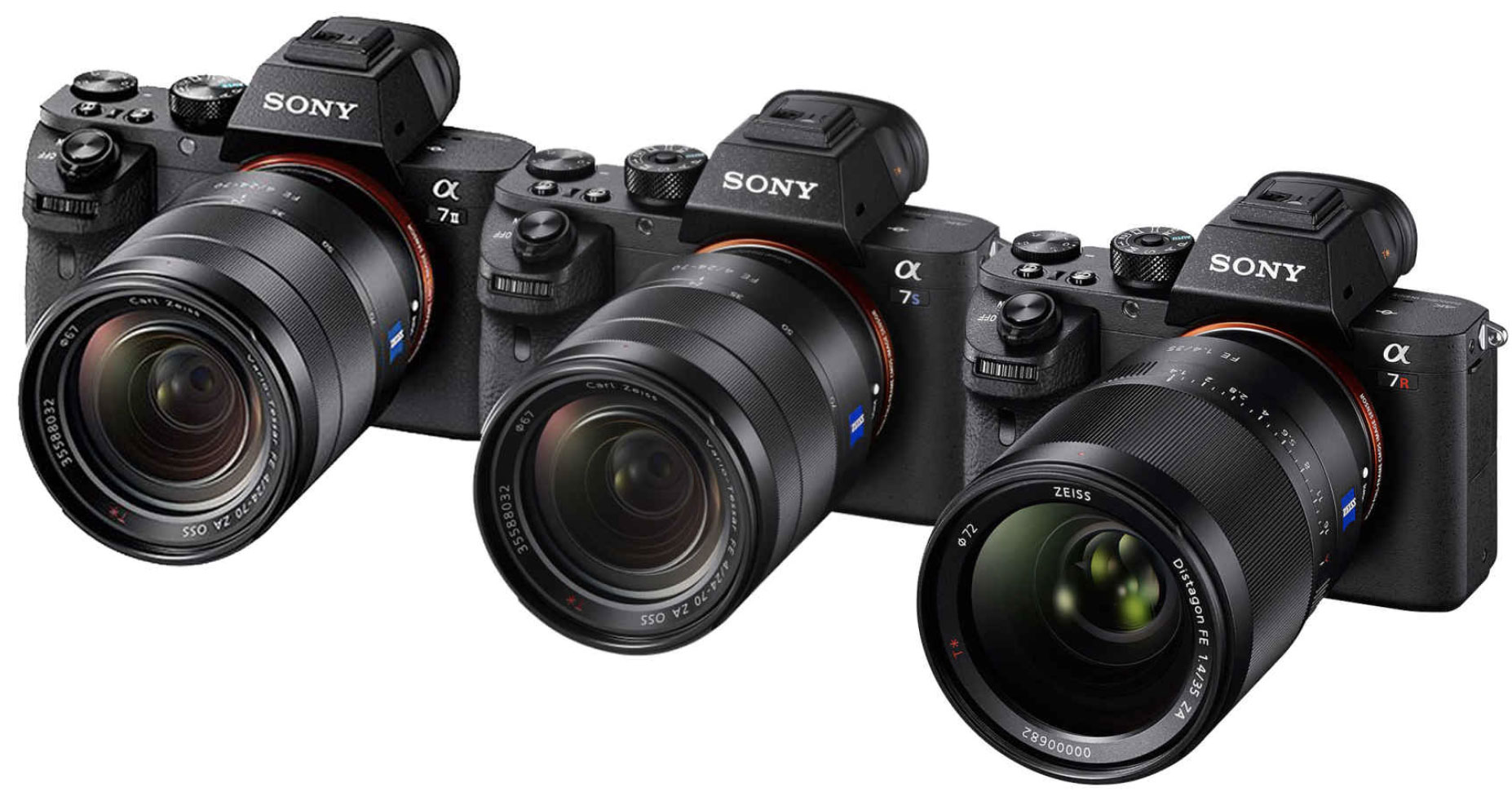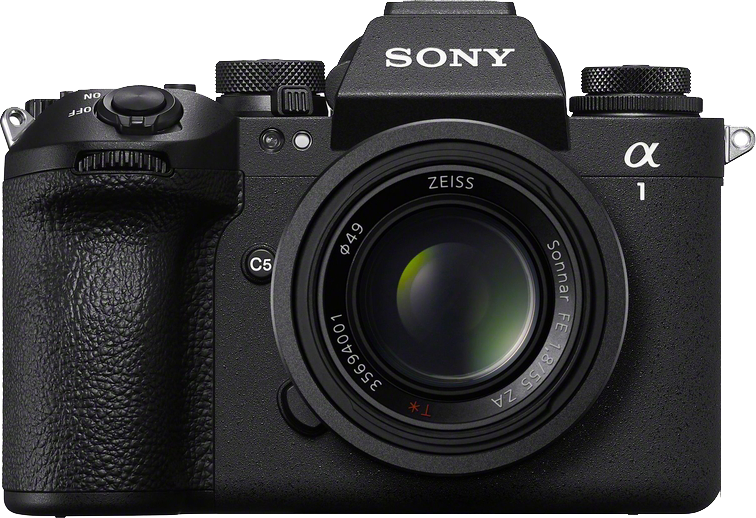|
Full-frame Sony Alpha |
Sony had bought Minolta in 2005 and proposed digital SLRs, first with classic mirror then in 2010 with semi-transparent mirror.
From 2010, Sony introduces a new E-mount for its APS-C mirrorless camera. In October 2013, Sony offered its first mirror-less hybrid camera with full-frame sensor and FE interchangeable lenses that keep the same E-mount frame.
In October 2013, Sony introduces a new E-mount and its first mirror-less hybrid camera with full-frame sensor and interchangeable lenses.
Sony creates a new market with two photo models (A7 and A7R), full-frame of 24 and 36 million pixels. This market is in fact a replacement/substitution market for the declining market for DSLRs.
The commercial strategy of Sony is different from those of other manufacturers that when they release a new camera, remove its predecessor, Sony uses a more original method of continuing to sell simultaneously several generations of cameras. Sony regularly introduces new versions of its cameras but continues to offer pre-sale models at a lower price, which allows the creation over time of a wide range of cameras from the oldest to the newest, the latter having the most complete features.
Design
|
Sony A7 R IV |
|
The shape of the Sony A7 also plays an important role. While coming from the Nex 7, it is built with a prism on the roof and commands identical to those of digital reflex with mirror chamber and optical premium. It would have been more convenient to have an electronic viewfinder on the left of the camera and adjustable as on some "compact" digital experts. |
|
Originality
|
Hasselblad Lusso |
The Sony A7 was not only the first full-frame hybrid, 24 x 36 mm, but it has the originality of allowing through its Wi-Fi chip not only to control the camera from a tablet or a smartphone but also to connect to the Sony Entertainment Network and download some applications to improve the functionality of the camera. Some of them are free, some others not. These applications allow to realize multiple exposures, to correct the optics defaults, to export the photos towards Flickr. Sony did not develop the Sony Entertainment Network nor open to outside developers the ability to create applications. This feature was probably not expected by the buyer of this type of camera: If you like pure Photography, you are not necessary a geek. |
||
Alpha's family.

The Sony Alpha are full-frame mirrorless cameras with interchangeable lenses. The Alpha 7 are available in the versatile A7 body, high definition A7R body and video oriented A7S. They are complemented by the Sony A9 and A1 as well as by a compact A7C body.
Sony Alpha 7
|
Sony A7 Mark IV |
passive heat dissipation of the Sony A7 Mark IV |
The Sony Alpha 7 (A7), introduced in 2103, is the first interchangeable lens compact camera equipped with a 35mm format. Compact, it replaces the NEX-7 and remains the most versatile model and the bestseller of the range. In 2013 and 2014, the Sony A7's are the only full-frame hybrids on the market. It has a 24.2 megapixel sensor.
The Sony A7 mark II brings in 2014 a backlit sensor, stabilization on 5 axes.
The Sony A7 mark III brings in 2017 a better autonomy and a design inspired by the A9.
The Sony A7 mark IV adds in 2021 a 33 Mpx full-frame back-illuminated Exmor R CMOS sensor and a Bionz XR dual-processor, an “hybrid” autofocus (phase correlation and contrast detection) with 759 AF points covering 94% of the sensor area, a native ISO range of ISO 100 to 204,800,
a 4K video at 60 fps in Super 35 mm, a swivel screen mounted on a ball joint, a burst mode at 10 fps. The Sony A7 IV is priced at $ 2,799 body only (November 2021).
Sony Alpha 7R
|
Sony A7R V |
The Sony Alpha 7R (A7R), launched in 2103 is as compact as the A7 but features a 36.4 megapixel low-pass filterless sensor with a burst at 5 fps. | ||
Sony Alpha 7S
|
Sony A7S III |
|
The Sony A7S (A7S), is a video-oriented version, introduced in 2014, able of shooting in 4K at 24/25/30 fps with a 12.2 megapixel sensor for better fluidity, a larger dynamic range (15.3 EV9), better digital noise management and sensitivity can reach 409,600 ISO.
The Sony A7S mark II brings in 2013 a 5-axis stabilization and autofocus from 25 detection points to 169.
The Sony A7S mark III brings in 2020 a 12.1 Megapixel backlit sensor, an AF with 759 phase detection points and 425 contrast points, a sensitivity from 40 to 409,600 ISO, 4K video sequences at 120 p, with a crop factor of 1.1, or Full HD video mode in 240p, a fully articulated rear screen and an Oled viewfinder with 9.44 million dots and a refresh rate of 120 Hz.
Sony Alpha 9
|
Sony A9 II |
The Sony A9 (A9), presented in 2107, is equipped with a full-size, backlit sensor offering a definition of 24.2 million pixels. Its CMOS "stacked" technology integrates a buffer. It can take 20 images of 24 MP per second and is stabilized on 5 axes. It has a high sensitivity to 204 600 ISO. The unit offers 4K / UHD video at 30 fps or Full HD at 60 fps. This is the professional version of the Sony A7 a fully built magnesium alloy case and a mechanical shutter for 500,000 cycles. |
||
|
Sony A9 III |
|
|
|
Other Sony Alpha cameras
|
2023 Sony A7 C |
|
||
|
2023 Sony A7CR |
In August 2023, Sony introduces the Sony A7 CR and Sony A7 C ii. |
||
|
2020 Sony A7C ii |
The Sony A7 C ii (A7Cii), a camera replacing the Sony A7C. This camera keeps the same compact design and unibody magnesium alloy construction and resistance to dust and moisture. It is built around the 33-megapixel BSI CMOS full-frame sensor, It has a new front command dial, a Bionz XR processor and a dedicated “AI processing engine”, allows 10 frames per second burst with AF, Full-width oversampled 4K from 7K, up to 30p or 4K/60p (from 4.6K capture) in Super35 / APS-C mode. It has a 3-inch 921,000-dot ball-jointed touchscreen, autofocus with tracking AF with subject recognition, 759 AF points with 94% frame coverage, 2.36 million XGA OLED Tru-Finder of points with a magnification of 0.59x and weighs 514 g. |
||
|
2021 Sony A1 |
Inside of Sony A1 (c) Kolari Vision |
On January 26, 2021, Sony launches the Sony Alpha 1.
Its ambition: to be the best SLR camera, quite simply. Outclassing the Canon R5, it has an impressive technical sheet: |
|
|
2024 Sony A1 II |
stabilisation du Sony Alpha 1 II |
In 2024, facing competition from the Nikon Z9 and the Canon R1, Sony is updating its Sony Alpha 1, launched almost 4 years ago. |
|
pierre j.

















